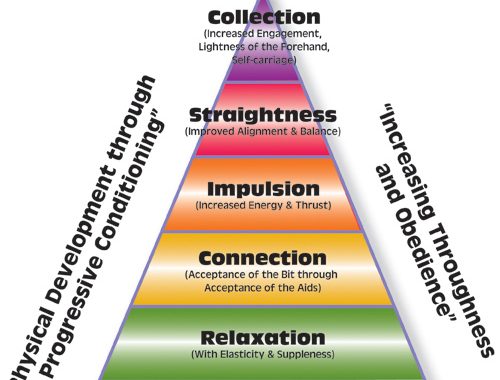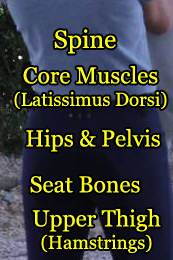
The Seat
The Holy Grail of Dressage
Dressage is a sport where riders continually work to improve themselves and their horses in an attempt to create perfect harmony. This harmony is developed over countless hours of riding, training, assessing and evaluating every movement and step of our riding. The key element to creating this symbiotic relationship between horse and rider is developing an independent, well-balanced, relaxed seat from which the rider is able to effectively communicate and become one with his equine partner. Richard Weiss said it best when he said, “Dressage is the art of teaching the horse to carry you. Riding is the art of learning to be a good load to carry.” Developing the seat is the foundation of becoming a “good load to carry.” It is from the seat that the rider is able to develop independence in the hand and leg and create and recycle the energy that is created by the horse’s hindquarter. In this article, we will discuss the what, why and how of the seat.
What is the seat?

The seat is by far the most important and influential of the rider’s aids. That is why so much attention has been given to it in countless dressage books, magazines, lectures and training sessions. The seat is the foundation from which all good riding comes. It not only helps the rider maintain his balance and allow his other aids to work independently, it is directly connected with the horse’s back, which is where all communication with the horse begins. When we are talking about the seat in riding, we are not talking merely of our derrière, posterior region, buttocks or whatever phrase you choose to use. We are talking about the primary line of communication with the horse. The most important of the aids. It is a common misconception that the seat only refers to the part of the rider’s anatomy that is in contact with the saddle. The seat, however, is so much more than that. It is essential to understand that the seat includes the seat bones, the upper thigh, the hips/pelvis, the core muscles and the spine. In some instances, the head and neck have even been known to be included when discussing the rider’s seat.

Because the seat encompasses so very much of the rider’s body, it is essential for the rider to develop an intimate understanding of the influence each of these areas has over the horse and how to control each area independently. It is also important to note that the rider’s seat is not a static entity from which the rider directs the horse. The seat is continually in motion consistent with the ebb and flow of the horse’s movement. This movement allows the energy created by the horse to flow freely over the horse’s back and into the rider’s hand where it is then recycled. Because the main elements of the seat are all connected, it is imperative that the rider dissect each aspect in order to better understand the synergistic relationship among its components.
The Seat Bones
Let’s first look at the seat bones – the two bony protrusions that you feel if you were to place your hands underneath your bottom while sitting on a chair. These are often the most thought of part when the seat is mentioned in a training session, which makes the most sense given this is actually a part of the bottom or seat. Allowing the seat bones to rest in the deepest part of the saddle will ensure that the rider maintains balance over the horse’s center of gravity. This placement of weight is essential when considering the overall goal of lowering the horse’s hips thus making him more capable of carrying the rider in balance and harmony
The Upper Thigh
Next, we will examine the upper thigh muscles. These muscles can often be our arch nemesis in riding because they are too often used to grip the horse in an effort to maintain balance. It is the quadriceps and hamstring muscles that most beginning level and even some intermediate level riders call upon when executing lateral movements, half halting and sitting the trot. When referring to the upper thigh muscles, the rider should also pay particularly close attention to the minute upper groin muscles. These tiny muscles have a significant influence over the rider’s ability to sit in the saddle. Where this becomes apparent is when the rider tries to sit the trot. If the rider unknowingly tightens these muscles, he will be left bouncing in the saddle much like an over inflated basketball on a hard gym floor. As a result, the horse will collapse his back and will no longer have a flow of energy from the hindquarter to the rider’s hand by way of the back, at which point the horse loses his ability to perform according to the training pyramid.
The Hips and Pelvis
The rider’s hips and pelvis play an integral role in the rider’s seat. Yes, they are directly connected to the actual seat bones, but their correct positioning will also determine how effectively the rider can sit in the saddle. If the hips and upper pelvis are rotated too far forward, the rider will hollow his back, thus pulling the seat bones out of the saddle and disengaging the horse’s back. When curled too far under, the rider will be continually giving the driving aid to the horse. This continual driving only makes the horse dull to the aids and too strong in the contact. The horse eventually falls on the forehand because he is driven through the contact. When positioned correctly, the hips and pelvis are aligned in such a way that the rider is able to maintain a deep seat and suppleness in his own back, thereby inviting the horse to engage his own back muscles in his work.
The Core Muscles
Trainers are continually asking riders to engage their core muscles especially when performing the half halt. In essence, the trainer is asking the rider to focus his attention on the abdominal and back muscles. These large muscle groups can create positive resistance against the horse’s movement, especially when asking for half halts and downward transitions. This engagement of the core muscles stills the rider’s back and seat and asks the horse, through his own back muscles, to step further underneath himself and lower his hindquarter. In essence, this enables the horse to perform downward transitions without falling onto the forehand. That is exactly how riders are able to get downward transitions without “pulling back” on the reins.
The Spine
The rider’s spine is the bony support system for the abdominal and back muscles. In order to be effective in riding, the rider must allow the spine to be mobile. It must flex and contract in time with the horse’s movements. The natural curvature of the spine enables the rider to weight the seat more heavily by flattening the lower curve of the spine or lighten the seat by rotating the pelvis slightly more forward. Please note that we are not suggesting that the rider sit in a forked seat. We are simply stating that increasing or decreasing the natural curvature of the spine ever so slightly can have a profound effect on the movement of the horse.
Why is the Seat so Important in Our Riding?
 So, why do we call the seat the “holy grail” of dressage? The seat is the foundation from which the rider will build the aids. When positioned correctly, the rider’s seat enables the rider to use each rein and leg aid independently. The seat also allows the rider to move “with the horse.” When the rider is sitting in balance with a relaxed and independent seat, the horse and rider develop a centaur-like appearance, one of unity and harmony.
So, why do we call the seat the “holy grail” of dressage? The seat is the foundation from which the rider will build the aids. When positioned correctly, the rider’s seat enables the rider to use each rein and leg aid independently. The seat also allows the rider to move “with the horse.” When the rider is sitting in balance with a relaxed and independent seat, the horse and rider develop a centaur-like appearance, one of unity and harmony.
If the rider’s seat is not well developed and balanced, the horse and rider appear disjointed and out of sync. The rider will begin flopping about on the horse’s back, especially during the trot. This lack of synchronicity causes the horse to disengage his hindquarter and back, thereby eliminating all aspects of the training pyramid.
How should the rider’s seat move in order to “go” with the horse? Let’s look at each gait to develop a better understanding of how the horse moves. These analogies are for visualization purposes and to help the rider to understand what it should “feel” like when ridden correctly.
Walk
In the walk, the rider will most notably feel a rising and falling on their own hips as the horse steps under with each hind leg. As the horse’s hind leg is on the ground underneath himself, the rider’s corresponding hip be up. When the horse lifts that same leg, the rider’s hip will lower. This is somewhat similar to pedaling a bicycle.
Trot
The trot is probably the most difficult gait for the rider to relax and feel. In rising trot, we will use the old phrase, “rise and fall with the leg on the wall.” This simply means you will “rise” or stand up when the outside, front hoof is forward and sit again when the outside, front hoof is back.
The sitting trot is the most difficult for most riders to stay relaxed and move in time with the horse. In an effort to better understand what you should be feeling, imagine you are sitting on the edge of your bed with your shoulders aligned over your hips. Then begin bouncing up and down on your seat much like you did as a child (c’mon you know you did this at least once when you were a kid. Lol). Keep your seat muscles relaxed and allow your abdominal muscles to open and close to absorb the shock. It is imperative when sitting the trot that you keep your seat and groin muscles relaxed. If you tighten those muscles, you will actually create more bounce. As I said before, your seat becomes like an over-inflated basketball being bounced against a gym floor. You want your basketball to be slightly flat so that you don’t bounce out of the saddle.
Canter
In the canter, we are going to go back to our childhood again. If you want to understand how the seat moves in the canter, imagine starting a swing. As you sit on the swing, you rock your pelvis underneath of you, then you straighten as you reach the highest point and then remain neutral as the swing travels backwards. Then, you drive your pelvis underneath again to push the swing forward. This back and forth motion of the pelvis occurs in the canter. As the outside hind leg is underneath the horse, you are rotating your pelvis underneath. In the 2nd beat of the stride, the pelvis is following the wave back to neutral position. In the moment of suspension, your pelvis is neutral and the cycle begins all over again.
Upward and Downward Transitions
Asking the horse to perform a transition should require little more than taking the positon of your seat to the next gait. For instance, if you wish to go from the walk to the trot, rock your pelvis slightly underneath and change the motion of your pelvis to the trot. When you wish to come back to the walk, stop trotting with your seat by tightening your abdominal muscles, growing tall as if someone were pulling you up toward the sky with a string, begin walking with your seat and if needed close your hand around your outside rein.
How does the seat work to influence the horse?
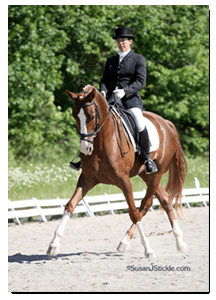 When referring to the influence of the seat, it is imperative for the rider to understand the effect that each seat has on his horse. The seat is not a static position that is maintained throughout the ride. As a matter of fact, the rider has several different seats that are used continually throughout a riding session in order to achieve the goals of the session.
When referring to the influence of the seat, it is imperative for the rider to understand the effect that each seat has on his horse. The seat is not a static position that is maintained throughout the ride. As a matter of fact, the rider has several different seats that are used continually throughout a riding session in order to achieve the goals of the session.
The Neutral Seat
The neutral seat is one that does not interfere with the horse’s movement. It is balanced and moves in perfect time with the horse’s gaits. The rider should sit in the middle of the horse’s back and maintain a straight line from the shoulder to the hip to the heel. In this position, there will be a slight curvature inward in the lumbar/lower back. The top of the pelvis tipped forward slightly so that they are in line with the seat bones. This will allow the legs to hang long beneath the rider. If the horse were removed from beneath the rider, the rider should land directly on their feet with a slight bend in the knee.
The Driving Seat
The driving seat asks the horse to step further underneath his center of gravity and to raise the forehand. The driving seat actually encourages impulsion and is mostly used when lengthening the horse’s stride. In the driving seat, the rider will rotate the pelvis underneath without leaning back with the torso and push more weight into the seat bones. This rotation of the seat in conjunction with the giving of the hand will ask the horse to lengthen his stride. Think of it as revving up the engine of a motorcycle and then releasing the clutch. The motorcycle will propel itself forward when the clutch is released much like the horse will propel himself forward when the rider “gives” with the rein. You don’t want to “pop” the clutch by throwing away the reins, you want to maintain a feel but allow the horse to lengthen or extend his frame and stride.
The Lightened Seat
The lightened seat allows the horse’s back to come up underneath and in the most extreme sense will encourage the horse to step backwards. In the lightened seat, the rider wants to feel like a puppet on a string. The puppet is pulled upward toward the sky with a string and the pelvis will rotate slightly forward. Once lightened, the rider should be able to draw the legs back slightly and close the hands around the reins. The horse should respond by stepping backward. It is important to note that the rider’s back should not become hollow/ have an over exaggerated inward curvature of the lumbar spine. This will place the rider in a forked seat causing the groin and thigh muscles to pinch and the seat bones to disengage from the saddle. A rider in this position, will not be able to maintain his balance and move synchronously with the horse.
The Stilled Seat
The stilled seat requires the rider to engage the core muscles (abdominal and back muscles) to prevent the rider’s back from continuing to move with the horse’s movements. Instead, the rider’s seat will provide some resistance against the movement, thus encouraging the horse to reduce his movement. When held momentarily, the rider will actually perform an effective half halt. If held longer, the rider will ask the horse to perform a downward transition.
As with any other aid, the rider should reward the horse when he responds appropriately by “giving” with the seat. The “giving” of the seat means returning to a neutral position and “going with” the horse’s movement. Maintaining a driving seat too long will often hollow the horse’s back, drive the horse through the contact and force him onto the forehand. A lightened seat that lasts too long will disengage the horse’s back and hindquarters leaving the hind legs to trail behind the horse eliminating any possibility of self-carriage and collection.
How can the seat be developed?
In essence, the seat is the most influential and important of the rider’s aids. As a result, the development of the seat should be the great quest of all riders, especially dressage riders. Developing the seat can be done in a variety of ways, both on and off the horse – although it is necessary to practice on the horse in order to develop the correct “feel.” The rider can also create the relaxation and suppleness necessary to “feel” the horse while unmounted.
DISCLAIMER: The techniques described below are recommendations of programs that have worked for other riders. Consult your physician before beginning any exercise program.
Seat Development Off the Horse
As riders, we are all aware that our position has a great impact on our horse’s ability to perform. Poor posture, lack of body awareness and inflexibility can drastically affect our horse’s ability to carry themselves and us. Riders, like horses, have a stronger side and weaker side. This muscle imbalance can wreak havoc on your riding. The techniques listed below outline several ways for riders to overcome muscle imbalance and develop strength.
Self Myofascial Release
Self Myofascial Release is an inexpensive form of self-massage using sustained pressure to help release tight, overactive muscles, reduce fascia restrictions throughout your body, improve mobility, and reduce muscle imbalance. This is an excellent place to start for those riders who suffer from muscle tension, poor posture, inflexibility and stiffness. Using a foam roller or small ball, you will help to release the tough connective tissue surrounding your bones, joints, muscles and organs. To learn more about these techniques, click here to view our Self Myofascial Release videos.
Stretching
Stretching is an important part of any riding program. Stretching not only helps the rider to elongate the long muscles, it also helps to eliminate lactic acid build up in the muscles caused by riding and any other physical activity. This is also important for increasing flexibility and mobility.
Exercises to Develop the Seat
Exercise programs like Pilates and yoga can be extremely beneficial for riders because they work to center the rider mentally and physically, increase flexibility and range of motion and help riders to learn how to isolate muscle groups. This is extremely important in learning how to use different parts of the body independently.
Seat Development On the Horse
Riding without Stirrups
Yes, we have heard it a million times before, riding without stirrups is a great way for a rider to develop their seat. And it is something that we highly recommend as well, but only if you have access to a reliable horse and person who can lunge your horse effectively. You will want to begin without reins and stirrups at the walk and work your way up to the canter. You may initially want to hold onto the pommel and cantle of the saddle and gently pull yourself down into the saddle. While your horse is moving, pay close attention to how your seat moves with each step. Practice using your different seats and see how they influence the horse’s gaits. After you have mastered the neutral, lightened, stilled and driving seat at the walk, step things up a notch. Try it at the trot and then the canter. You might even try riding with a couple glasses of water to see how independent your hands are after riding without stirrups for a while.
After you are able to maintain your balance on the lunge, you can take up your reins and navigate your horse through your training sessions. Give it a go for the next 30 days and see how well riding without stirrups improves your seat. Don’t worry, we are sure you will notice a remarkable difference.
As you can see, the seat is an extremely important part of dressage and riding. It is imperative that the rider make every effort to develop an independent, well-balanced and relaxed seat so that they can effectively influence their horse. It is through the seat that the rider will be able communicate with his horse and make his desires know without interfering or inhibiting his horse’s movement and expression.
Author: Dressage Academy
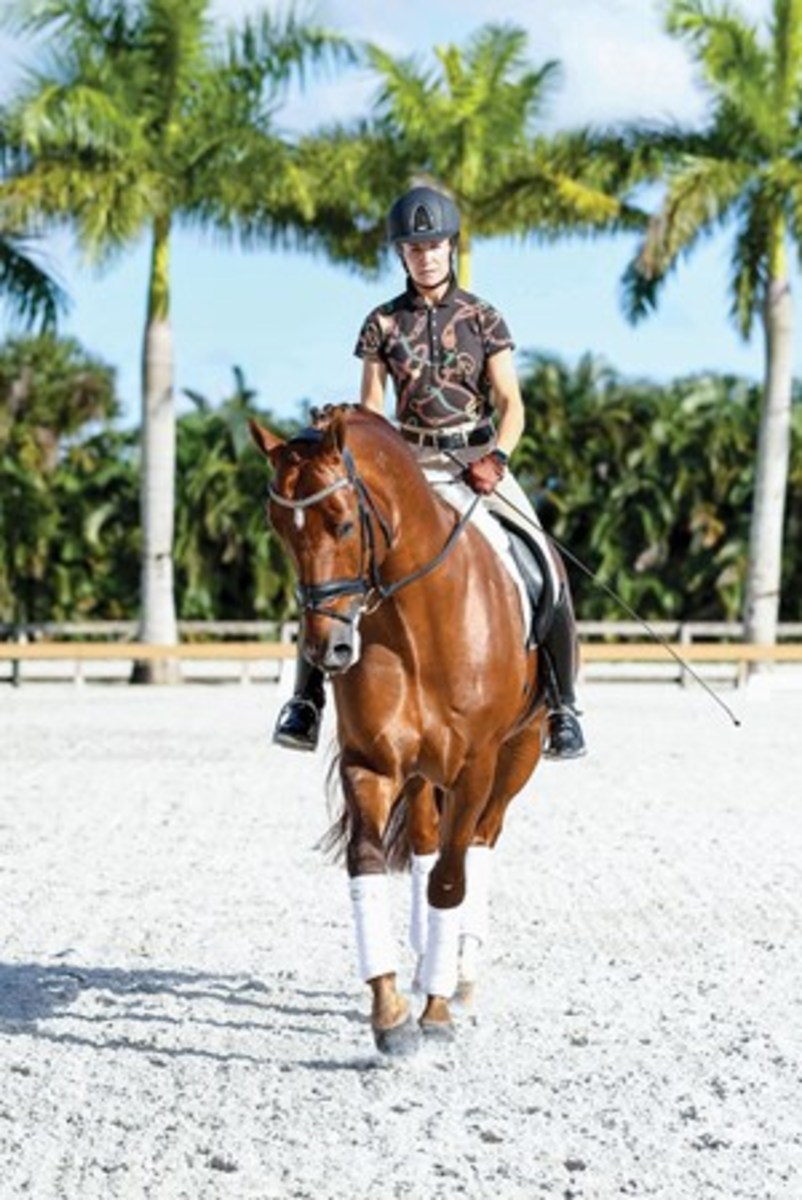
Tips on Riding Shoulder Fore
3 Loop Serpentine
You May Also Like
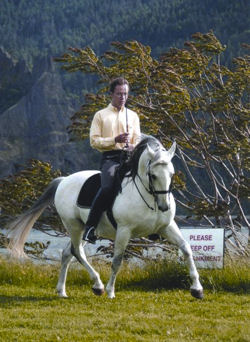
Rejuvenate Your Dressage Horse
July 6, 2017
Food for Thought
July 10, 2017